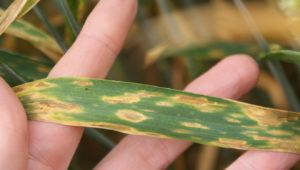Update of fungicide efficacy and resistance
11 December 2017Commercially, and in field trials, cereal fungicide programmes were pretty effective in 2017 and yield responses to fungicides reasonable but the dry spring did much to keep a lid on the disease burden in Scottish crops so it wasn’t the highest pressure disease year we have seen. That is doubly fortunate because we are continuing to build problems with fungicide resistance with new and unwelcome examples seen each season. Many major diseases like septoria in wheat are extensively monitored so that issues with resistance are understood with relatively little delay but others, like many of the barley diseases, get proportionally little attention so it can be hard to decipher what is going on.
Earlier this month the Fungicide Resistance Action Group UK brought together scientists and agrochemical experts in the country to look at the state of play this year. Early data from this season seems to show a growing concern over the emerging resistance issues to SDHI fungicides in septoria. There seems to be good and bad new on this front though. The mutations found that confer some level of reduced sensitivity continue to be detected at increased frequency and with more complex examples, but the most impactful mutation appears to carry a fitness penalty so that it has died away over last the two winters and then remerged when SDHI usage starts. Lab tests at Rothamsted confirm that if SDHIs are not used it dwindles in a population. This carries a really useful message about fungicide usage and the hope that we can collectively manage the risk and retain the chemistry. Mutants like this only survive where the rest of the population is heavily controlled with SDHIs and so best practices such as reducing the number of SDHI containing sprays and mixing and alternating actives have real effect. The sensitivity of septoria to the azoles has declined over many years but there doesn’t seem to have been any further shift in 2017. Also encouragingly there has been a greater uptake of varieties with a higher septoria rating on farms which, over the piece, will reduce pressure on chemistry.

Ramularia has developed resistance to both azole and SDHI chemistry in an unprecedented stepwise shift
News on barley diseases is worrying. In 2016 reduced sensitivity to both azoles and SDHIs was picked up in SRUC and commercial testing. Field trial data from 2017 at our sites shows an almost complete loss of efficacy against ramularia from azoles and SDHIs. That double loss of efficacy in such a stepwise manner is unprecedented and leaves us reliant on the multisite chlorothalonil for ramularia management next season at the T2 booting timing. There were other issues in barley too. Efficacy of strobilurins against rhynchosporium was still seen in field trials but with a small reduction which would seem consistent with Teagasc Irish data that shows that the G143A mutation is now present in the population. Net blotch is also affected with a partial resistance to the strobilurins and to the SDHIs and that too played out as a slight reduction in efficacy in field trials. In barley we tend to deal with a basket of disease issues so both practically and from a resistance management perspective using a range of mixed and alternated chemistry is sensible. Selecting varieties with improved resistance ratings helps to reduce the risk of the diseases that you notice most on the farm and is a really useful way to reduce the need for, and pressure on, chemistry.
Fungicide resistance is something we should all worry about. It’s not just some academic problem that someone else can deal with. Individually following better stewardship practices such as using resistant varieties and mixing and alternating risky actives and using multisites will make a difference and benefit us all. The next new actives are 2 or 3 years away and we need to keep what we have until then – and longer if we want to support the new chemistry.
Fiona Burnett (SRUC) for the Farm Advisory Service
Sign up to the FAS newsletter
Receive updates on news, events and publications from Scotland’s Farm Advisory Service
